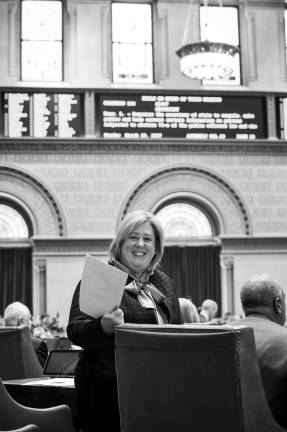breast cancer screening bill advances

Patients would not incur out-of-pocket costs for 3-dimentional mammograms, which are better at detecting breast cancer than more common 2-D imaging procedures, according to a bill passed by the Assembly last month.
The bill, sponsored by Assembly Member Rebecca Seawright, would require medical insurance policies within New York to cover the procedure, called breast tomosynthesis. Seawright, who represents the Upper East Side, Yorkville and Roosevelt Island, said she sponsored the bill after hearing from local medical professionals about the lack of coverage.
“Insurance weren’t covering 3-D mammogram screenings and they felt like they should be required to,” Seawright said of the doctors she spoke with. “I feel the 3-D mammograms are one of the strongest weapons in combating and fighting breast cancer because it promotes early detection and we all know that early detection is key.”
Seawright suggested that the Assembly’s 146-0 vote on March 30 indicated a crucial need for the procedure’s widespread availability.
“The legislature is predominantly men but I think men get breast cancer,” Seawright said. “They have daughters, wives, nieces, women in their lives and I think they see the importance of the bill.”
The state Senate will now consider the bill.
Dr. Nicole Saphier, a healthcare legislation advocate and clinician at Memorial Sloan Kettering Cancer Center — the hospital that first approached Seawright about the possibility of authoring a bill — described the issues that can arise with the limited scope available in 2-D imaging.
“The problem with that is there was a lot of overlapping tissue, what we call the ‘masking effect,’ so a lot of cancers were being hidden,” she said. “Now what we’ve done is we reconstruct 3-D images, which means that we take several more images from different angles, put them together, and make a volumetric model of the breast, just like you’d see in real life, and that way not only are we finding more cancer, we’re also not having as many false positives.”
Clinicians are also able to detect smaller masses through much denser tissue than they could with 2-D scans. Christy Gamble, director of health policy and legislative affairs for the Black Women’s Health Imperative, a national nonprofit, said the will directly benefit women she advocates for.
“3-D mammography is the best screening tool out there for detecting breast cancer in women with dense breast tissue and unfortunately black women more than likely are going to have dense breast tissue,” Gamble said. “Using the traditional 2-D mammogram, for a lot of black women there’s a misdiagnosis, there’s the possibility of having further callbacks, which is very expensive, and unfortunately black women tend to disproportionately make up those in the low income population.”
Many insurance plans do not cover 3-D mammograms. Of the ones that do, there tends be substantial out-of-pocket costs.
“Insurance has been giving us a really hard time about it, saying that it is still investigational, however, it absolutely is not still investigational,” Saphier said. “We have several very large robust studies that prove its efficacy and now we’re starting to see states covering it because they’re finally acknowledging that it is the new standard of care for women.”
While the price of 3-D mammograms is significantly higher than their 2-D predecessors, Seawright, Gamble and Saphier all agree the long-term savings outweigh the initial costs.
“The 3-D right now is about three times more expensive, but if you factor in the long-term effect of finding the cancer earlier, it will be less expensive to treat it,” Saphier said. “It’s much less expensive to treat an early cancer than a late-stage cancer.”
According to Saphier, 30 percent more cancers are being detected and 25 percent fewer people are being called back due to uncertainty in results.